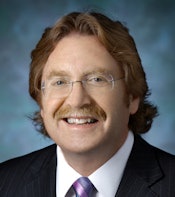
Radiology has an image problem: Many patients still don't understand who radiologists are and what they do, and referring physicians may believe that radiology provides a commodity rather than physician skill. But social media can help, according to a talk at the recent International Symposium on Multidetector-Row CT (MDCT).
Social media can help radiology improve its image by giving practices more control over how they are perceived by the public, Dr. Elliot Fishman from Johns Hopkins Hospital said at the San Francisco meeting.
 Dr. Elliot Fishman from Johns Hopkins University.
Dr. Elliot Fishman from Johns Hopkins University."Social media gives radiology and radiologists the chance to rebrand ourselves and our role in healthcare," he said. "People need to realize that radiology plays a crucial role in healthcare."
The invisible radiologist?
In his talk, Fishman referred to two 2011 articles written by the late Dr. Gary Glazer, one called "The Invisible Radiologist" and another called "Decades of Perceived Mediocrity."
Glazer discussed how a 2008 national survey conducted by the American College of Radiology (ACR) found that one in two Americans didn't know whether a radiologist interprets or administers imaging exams. Also, many individuals believe radiology is a profession with "little intellectual stimulation" and imaging services are "commodities distinguished by cost rather than expertise," he wrote (Radiology, January 2011, Vol. 258:1, pp. 18-22; August 2011, Vol. 260:2, pp. 311-316).
Radiologists can use social media to change these perceptions and to clarify several important questions:
- What is radiology and who are radiologists?
- What do radiologists do?
- What do various imaging exams provide and what are their limitations?
- What is the role of radiology in the care of patients?
The effects of social media can be seen on a number of levels. Radiologists can use social media tools not only to facilitate communication with patients, but also with referring physicians, trainees, and even other radiologists. And these tools can help radiologists set the terms of debate for the appropriateness of different imaging tests or the importance of the radiologist's role in patient care, Fishman said.
"The importance for radiologists getting involved in social media is to explain what we're doing, to put ourselves in the context of healthcare, and to develop trust with patients," he said.
Fishman cited the example of his CTisus.com website, which provides CT information to imaging professionals.
"We're touching a lot of people on a daily basis," he said. "The CTisus Facebook page has 47,000 likes -- comparable to the RSNA and ACR pages, which both have about 53,000. So you can have lots of engagement without a budget for this kind of outreach."
Radiologists need to care about social media because their patients care about it, Fishman said. Patients expect medical resources to be available on social media.
The question isn't whether social media is affecting your radiology practice, because it is, he concluded. "The question is really: Are you going to participate or not?"




















